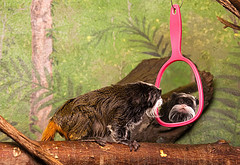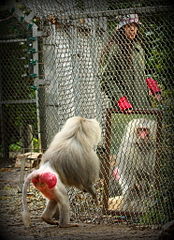 Humans use mirrors so easily that we often don’t think about the cognitive processes required to do so (although we do derive entertainment from those animals that just don’t “get” mirrors). Being able to recognize oneself in the mirror doesn’t seem like an evolutionarily advantageous skill, but scientists think that this ability may indicate the possession of other skills more relevant to survival.
Humans use mirrors so easily that we often don’t think about the cognitive processes required to do so (although we do derive entertainment from those animals that just don’t “get” mirrors). Being able to recognize oneself in the mirror doesn’t seem like an evolutionarily advantageous skill, but scientists think that this ability may indicate the possession of other skills more relevant to survival.
For example, mirror self-recognition may be indicative of self-consciousness and, by extension, theory of mind (the ability to think about what others may be thinking); being self-conscious, or having knowledge of the self, may naturally lead to having knowledge of others. These skills are especially important for social animals, as theory of mind allows us to take the perspective of others, which is the basis for empathy. (Evidence for the connection between mirror self-recognition and theory of mind comes from studies with young children, which have found that mirror self-recognition and perspective-taking abilities develop at around the same time.)
But how can we tell whether animals and pre-linguistic children connect what they see in the mirror to their physical selves? The most commonly used measure is the Mirror Test (also called the Mark Test or the Rouge Test), which was developed by Gordon Gallup, Jr. in 1970. After a familiarization period with a mirror, a colored mark is placed on an area of an animal that can’t be seen without the use of a mirror (usually somewhere on the face). The animal is then exposed to a mirror again, and her behavior is closely monitored. If the animal touches the mark on her own face (rather than the mirror), then she has “passed” the Mirror Test and demonstrates mirror self-recognition.
When first exposed to a mirror, most animals (including humans) exhibit social behaviors like lip smacking and attempts to play, indicating that they perceive their reflection as a conspecific. After some cognitive development and experience with mirrors, however, some animals will demonstrate mirror self-recognition (for humans, this occurs around 18-24 months of age).
Unsurprisingly, humans’ closest evolutionary relatives, the great apes, demonstrate mirror self-recognition (the great apes include chimpanzees, bonobos, gorillas, and orangutans; all have passed the Mirror Test). Additionally, some very distant relatives of humans, but who are also highly social and have demonstrated advanced cognitive abilities, have passed the Mirror Test: dolphins and elephants.
One unexpected species that has passed the Mirror Test is the magpie. But when you consider their other cognitive abilities, it’s not so surprising: magpies have also demonstrated the abilities of tool use, perspective-taking, and foresight. (Why would these abilities be particularly helpful to magpies? Researchers theorize that they enable magpies’ prolific thievery.)
 Interestingly, lesser apes (gibbons) and monkeys fail the Mirror Test, suggesting that mirror self-recognition and all the attendant cognitive abilities (self-consciousness, perspective-taking, etc.) evolved after the evolutionary split between great and lesser apes (which occurred after the split between apes and monkeys). Elephants, dolphins, and magpies, then, must have evolved the abilities through convergent evolution.
Interestingly, lesser apes (gibbons) and monkeys fail the Mirror Test, suggesting that mirror self-recognition and all the attendant cognitive abilities (self-consciousness, perspective-taking, etc.) evolved after the evolutionary split between great and lesser apes (which occurred after the split between apes and monkeys). Elephants, dolphins, and magpies, then, must have evolved the abilities through convergent evolution.
So it seems pretty simple: pass the Mirror Test, and you demonstrate mirror self-recognition and its associated cognitive abilities. Yet, as with most matters in animal cognition, this one is far from cut-and-dry.
Some researchers have argued that the Mirror Test isn’t appropriate for many animals. First, a colored mark on the face may not be salient enough for some animals (it may not stand out or be important enough for the animals to notice). Additionally, just because an animal doesn’t touch or try to remove the mark doesn’t mean he doesn’t recognize his reflection; perhaps he notices the mark but just doesn’t care. Finally, what about animals who have poor vision, or who rely primarily on other senses? Surely we can’t say they lack the abilities of self-consciousness and perspective-taking simply because they don’t pass the Mirror Test.
This issue is complicated even when studying children: some studies have shown vast cultural differences in performance on the Mirror Test. For example, many of the Kenyan children in one study froze in response to seeing their reflections. While some of these cultural differences could be attributed to differences in experience with mirrors, researchers think they are likely more related to different parenting styles and differences in how the children understand the task. Children raised in cultures with a high emphasis on obedience, for example, may recognize their reflections but be unsure of whether they’re allowed to investigate or remove the mark.
 These criticisms of the Mirror Test have prompted some researchers to try to find other methods of gauging whether animals demonstrate mirror self-recognition. Some possible alternative indicators include mirror-guided self-directed behaviors (like using the mirror to examine one’s body) and the disappearance of social responses to the mirror. Some researchers attempted to use these indicators as proof that macaques can recognize themselves in the mirror, although their interpretation has been questioned. (I highly recommend reading these papers and judging for yourself – you can find the original paper here. Unfortunately, the rebuttal paper isn’t available for free, but the same authors briefly discuss their criticisms in this article.)
These criticisms of the Mirror Test have prompted some researchers to try to find other methods of gauging whether animals demonstrate mirror self-recognition. Some possible alternative indicators include mirror-guided self-directed behaviors (like using the mirror to examine one’s body) and the disappearance of social responses to the mirror. Some researchers attempted to use these indicators as proof that macaques can recognize themselves in the mirror, although their interpretation has been questioned. (I highly recommend reading these papers and judging for yourself – you can find the original paper here. Unfortunately, the rebuttal paper isn’t available for free, but the same authors briefly discuss their criticisms in this article.)
This brings me to a tangential point about scientific research in general. These kinds of exchanges regularly occur in science, regardless of the particular field. Often, one researcher (or a group of researchers) finds an issue with another researcher’s methods or conclusions. Sometimes she will just write a rebuttal pointing out the flaws she sees or offering an alternate interpretation of the results, but she may also conduct her own experiment, fixing any methodological flaws from the original study. While it is undoubtedly frustrating to have your methods and conclusions questioned, it ultimately leads to better science by pushing researchers to really think about and improve task design and to be very careful about interpreting results.
It is also the theoretical basis of how we disseminate findings in the scientific community: after careful consideration by other scientists in the field (peer review), we publish not only the conclusions of our experiments, but also our exact methods, our data, and the related prior research that helps lead us to those conclusions. In essence, we tell a story about our research. Others can then follow along and, rather than taking our word for it, decide for themselves whether our story is compelling and what makes it so (or not).
(As I said, though, this is all in theory. There is currently quite a bit of debate concerning how papers are chosen for journals, whether access to these papers should be free to everyone, and a host of other issues relating to publishing scientific research.)
 But I digress. Hopefully this was a thought-provoking summary of what mirror self-recognition can (but possibly can’t) tell us about certain cognitive abilities. I’ll leave you with this video about the Mirror Test in primates (starts at 1:00), and this one about dolphins and elephants.
But I digress. Hopefully this was a thought-provoking summary of what mirror self-recognition can (but possibly can’t) tell us about certain cognitive abilities. I’ll leave you with this video about the Mirror Test in primates (starts at 1:00), and this one about dolphins and elephants.
Sources:
Anderson, James R., and Gordon G. Gallup. “Do rhesus monkeys recognize themselves in mirrors?.” American journal of primatology 73.7 (2011): 603-606.
Anderson, James R., and Gordon G. Gallup Jr. “Which primates recognize themselves in mirrors?.” PLoS biology 9.3 (2011).
Broesch, Tanya, et al. “Cultural variations in children’s mirror self-recognition.” Journal of Cross-Cultural Psychology 42.6 (2011): 1018-1029.
de Waal, Frans BM. “The thief in the mirror.” PLoS biology 6.8 (2008).
Gallup, Gordon G. “Chimpanzees: self-recognition.” Science (1970).
Plotnik, Joshua M., Frans BM De Waal, and Diana Reiss. “Self-recognition in an Asian elephant.” Proceedings of the National Academy of Sciences 103.45 (2006): 17053-17057.
Prior, Helmut, Ariane Schwarz, and Onur Güntürkün. “Mirror-induced behavior in the magpie (Pica pica): evidence of self-recognition.” PLoS biology 6.8 (2008): e202.
Rajala, Abigail Z., et al. “Rhesus monkeys (Macaca mulatta) do recognize themselves in the mirror: implications for the evolution of self-recognition.” PLoS One 5.9 (2010): e12865.
Reiss, Diana, and Lori Marino. “Mirror self-recognition in the bottlenose dolphin: A case of cognitive convergence.” Proceedings of the National Academy of Sciences 98.10 (2001): 5937-5942.
Suddendorf, Thomas, and David L. Butler. “The nature of visual self-recognition.” Trends in cognitive sciences 17.3 (2013): 121-127.
Also interesting:
Platek, Steven M., and Sarah L. Levin. “Monkeys, mirrors, mark tests and minds.” Trends in ecology & evolution 19.8 (2004): 406-407.
Suddendorf, Thomas, and David L. Butler. “Response to Gallup et al.: are rich interpretations of visual self-recognition a bit too rich?.” Trends in cognitive sciences (2013).



